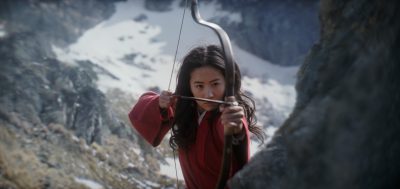The beloved 1998 animated film “Mulan” delivered catchy songs, an inspiring story line and some of our favorite Disney moments. This time around, Disney has changed almost all of that in exchange for the historical accuracy of the original fable, along with honoring Chinese traditions, in its revamped 2020 remake.

Disney’s more than $11 billion studio entertainment budget is in flux as a result of closed theaters and delayed filming because of the COVID-19 pandemic. “Mulan” was released Friday directly onto the company’s streaming service, Disney+, for those with a Premier Access pass, which requires a one-time purchase of $29.99. The film will be free to all Disney+ subscribers on Dec 4.
The movie, directed by Niki Caro, begins with Hua Mulan as a young woman in ancient China. When the emperor calls for one man from each family to fight in the war, Mulan, one of two daughters, is devastated to see her decrepit father accept the scroll to fight. In the night, she takes her father’s armor and weapons to fight in his place, disguised as Hua Jun.
The 2017 announcement that the classic songs would not be returning for the remake yielded mixed initial reactions. However, the decision was a good one — focusing more on the Chinese culture paid more respect to the story’s origins without the Disney songs, giving the movie more authenticity and intensity.
Other Disney live-action remakes, including 2016’s “The Jungle Book,” 2015’s “Cinderella” and 2017’s “Beauty and the Beast,” copied and pasted the animation to screen, but the script changes to “Mulan” were refreshing.
The visuals and colors are reminiscent of a vibrant, animated Disney movie, and the dance-like choreography of fight scenes were similar to those in Ang Lee’s “Crouching Tiger, Hidden Dragon.”
When Mulan is meeting with the matchmaker, she wears a vibrant purple kimono, surrounded by soft yellows and earthy brown landscapes. Later in the film, these colors are juxtaposed to the bright, strong red of her uniform that stands out against the desolate war zone scenes, her black hair glistening.
Mulan possesses a very powerful chi, or energy, from a young age and must hide it away — if a woman uses her chi to be a warrior, she is a witch. When she unleashes her chi in battle, Mulan proves herself more powerful, majestic and distinguished than any other soldier. Her scenes as a child and a warrior are beautiful and martial arts-inspired, with embellished choreography.
The film also takes the opportunity to show the other side of the coin: on the opposing side to the Imperial Army is Bori Khan, an army commander who leads with a female fighter, Xianniang, of similar chi to Mulan. This “witch” tempts Mulan to betray the Imperial Army as they have, but Mulan relies on loyalty and bravery in a world where women are not given a fair chance.
Another change from the original film was the inclusion of Mulan’s love interest, Shang Li. In fact, he was not included at all, and his character was split into two: a commander who leads with courage and dignity, and a sweet, charming soldier of her rank. This removes the awkwardness and potentially toxic power dynamic that a relationship between a general and subordinate imposes, and instead introduces romantic undertones with another soldier, Mulan’s equal.
The movie does remind viewers of its origins, even if those origins are at times the 90s Disney film, not the fable. The sweeping symphonic music and grand moments are magnified with the main theme to “Reflection,” “Honor to Us All” and even “I’ll Make a Man Out of You.” And although the film was extremely different plot-wise, little details acted almost as types of fun Easter eggs to follow along from the animated film.
Disney made the right decision to cast a Chinese actress relatively unknown outside of China — by doing so, the film avoided white-washing and removing authenticity from the story, and the casting introduced American audiences to new actors outside of traditional American-washed cinema. The fable is Chinese, and so too should the cast be.
In the 1998 film, Mulan is banished when her true gender is revealed. In 2020, this is still true, but Mulan goes back this time and is accepted to lead the army to save the emperor. She bursts through the gates of the Imperial City as Hua Mulan, not Hua Jun. She leads her group of soldiers, long hair flying in the wind. She leads as a woman, not a woman pretending to be a man. The movie, directed by a woman, leaves the viewer with Mulan as a “legend.”





While the review slightly referenced more cultural current events in regards to white-washing and the casting of a Chinese actress, it fails to address the elephants in the room with the casting and filming of Mulan. Liu Yifei, the actress playing Mulan, has previously tweeted her support for the Chinese government intervention in Hong Kong, in which there have been massive pro-democracy protests quelled by the Communist government, which has resulted in aggressive police brutality within the region. Furthermore, the filming of Mulan happened within Xinjiang, the same provinces where the CCP is holding over a million Uighur Muslims against their will. Overall, it just seems inaccurate to address white-washing, while completely ignoring the main actresses’ support for an oppressive regime and the proximity to detainment camps. While Disney may have made the right decision in properly casting a Chinese actress, their ignorance for basic human rights is appalling, and abhorrent.
The main actor of his movie has spoken out in support of police brutality in Hong Kong, against citizens who have been fighting for democracy and freedom. While the cast is all Asian, the behind the scenes is not at all – director, cinematographer, casting, everything – essentially a Chinese story told by white people. No thanks. The credits of this movie also give thanks to an institution in the Xin Jiang province connected to the continual genocide of Uyghur Chinese Muslims. Netflix released this film – with NO options for any Chinese language audio or even subtitles. How can this movie which you claim to be authentic not even allow viewers of the very culture represented to understand and enjoy it? What’s more, the movie comparison made is somewhat unfortunate: do you know any Chines movies other than “Crouching Tiger, Hidden Dragon”? This was a tone-deaf article, apparently done without much research, since a quick google of criticisms on the movie would show all of the things I have pointed out.